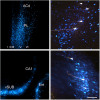Chronic stress-induced alterations of dendritic spine subtypes predict functional decrements in an hypothalamo-pituitary-adrenal-inhibitory prefrontal circuit
- PMID: 24005291
- PMCID: PMC3761048
- DOI: 10.1523/JNEUROSCI.0287-13.2013
Chronic stress-induced alterations of dendritic spine subtypes predict functional decrements in an hypothalamo-pituitary-adrenal-inhibitory prefrontal circuit
Abstract
Activation of the hypothalamo-pituitary-adrenal (HPA) axis plays a vital role in promoting adaptation during acute stress, but adverse effects of chronic stress may result from overactivity of this system. Recent evidence highlights a subdivision of GABAergic neurons within anterior bed nuclei of the stria terminalis (aBST) that integrates and relays inhibitory influences to HPA-effector neurons in paraventricular hypothalamus during acute stress, notably from medial prefrontal [prelimbic (PL)] and hippocampal [ventral subiculum (vSUB)] cortical fields. Here we localize the site and candidate mechanism of neuroplasticity within upstream regions of this inhibitory network after chronic variable stress (CVS). Rats bearing retrograde tracer injections in aBST underwent CVS for 14 d. Retrogradely labeled and unlabeled neurons in vSUB and PL were selected for intracellular dye filling, followed by three-dimensional imaging and analysis of dendritic arborization and spine morphometry. Whereas PL neurons displayed decreases in dendritic branching and spine density after CVS, aBST-projecting cells showed a selective loss of mature mushroom-shaped spines. In a follow-up experiment, CVS-treated and control rats were exposed to a novel restraint challenge for assay of HPA activation and engagement of aBST-projecting cortical regions. CVS animals showed enhanced HPA output and decreased Fos activation in aBST-projecting PL neurons compared with acutely stressed controls. In contrast, vSUB failed to show any significant differences in structural plasticity or functional activation patterns after CVS. These findings define a mechanism whereby synaptic destabilization in the PL → aBST pathway may dampen its ability to impart inhibitory control over the HPA axis after chronic stress exposure.
Figures







Similar articles
-
Evidence for involvement of a limbic paraventricular hypothalamic inhibitory network in hypothalamic-pituitary-adrenal axis adaptations to repeated stress.J Comp Neurol. 2015 Dec 15;523(18):2769-87. doi: 10.1002/cne.23815. Epub 2015 Jun 18. J Comp Neurol. 2015. PMID: 26010947 Free PMC article.
-
Prolonged corticosterone exposure induces dendritic spine remodeling and attrition in the rat medial prefrontal cortex.J Comp Neurol. 2016 Dec 15;524(18):3729-3746. doi: 10.1002/cne.24027. Epub 2016 May 17. J Comp Neurol. 2016. PMID: 27113541 Free PMC article.
-
A discrete GABAergic relay mediates medial prefrontal cortical inhibition of the neuroendocrine stress response.J Neurosci. 2009 Jun 3;29(22):7330-40. doi: 10.1523/JNEUROSCI.5924-08.2009. J Neurosci. 2009. PMID: 19494154 Free PMC article.
-
Anteroventral bed nuclei of the stria terminalis neurocircuitry: Towards an integration of HPA axis modulation with coping behaviors - Curt Richter Award Paper 2017.Psychoneuroendocrinology. 2018 Mar;89:239-249. doi: 10.1016/j.psyneuen.2017.12.005. Epub 2017 Dec 24. Psychoneuroendocrinology. 2018. PMID: 29395488 Free PMC article. Review.
-
Limbic system mechanisms of stress regulation: hypothalamo-pituitary-adrenocortical axis.Prog Neuropsychopharmacol Biol Psychiatry. 2005 Dec;29(8):1201-13. doi: 10.1016/j.pnpbp.2005.08.006. Epub 2005 Nov 4. Prog Neuropsychopharmacol Biol Psychiatry. 2005. PMID: 16271821 Review.
Cited by
-
Cocaine disrupts action flexibility via glucocorticoid receptors.iScience. 2024 May 28;27(7):110148. doi: 10.1016/j.isci.2024.110148. eCollection 2024 Jul 19. iScience. 2024. PMID: 38989467 Free PMC article.
-
Repeated exposure to multiple concurrent stressors alters visual processing in the adult posterior parietal cortex.Neurobiol Stress. 2024 Jul 5;31:100660. doi: 10.1016/j.ynstr.2024.100660. eCollection 2024 Jul. Neurobiol Stress. 2024. PMID: 39100726 Free PMC article.
-
Top-down and bottom-up control of stress-coping.J Neuroendocrinol. 2019 Mar;31(3):e12675. doi: 10.1111/jne.12675. Epub 2019 Feb 1. J Neuroendocrinol. 2019. PMID: 30578574 Free PMC article. Review.
-
Optogenetic Control of Spine-Head JNK Reveals a Role in Dendritic Spine Regression.eNeuro. 2020 Feb 20;7(1):ENEURO.0303-19.2019. doi: 10.1523/ENEURO.0303-19.2019. Print 2020 Jan/Feb. eNeuro. 2020. PMID: 31937523 Free PMC article.
-
Adrenocortical status predicts the degree of age-related deficits in prefrontal structural plasticity and working memory.J Neurosci. 2014 Jun 18;34(25):8387-97. doi: 10.1523/JNEUROSCI.1385-14.2014. J Neurosci. 2014. PMID: 24948795 Free PMC article.
References
Publication types
MeSH terms
Grants and funding
LinkOut - more resources
Full Text Sources
Other Literature Sources
Medical
Miscellaneous
